Disclaimer
James McNeill Whistler
American Aesthetic Painter and Engraver
1834 - 1903
Self Portrait of James McNeill Whistler

James Abbott McNeill Whistler was an American-born, British-based painter and etcher. Averse to sentimentality in painting, he was a leading proponent of the credo "art for art's sake". He took to signing his paintings with a stylized butterfly, possessing a long stinger for a tail. The symbol was apt, for Whistler's art was characterized by a subtle delicacy, in contrast to his combative public persona. Finding a parallel between painting and music, Whistler titled many of his works 'harmonies' and 'arrangements'.
Whistler was born to George Washington Whistler, a prominent engineer, and Anna Matilda McNeill in Lowell, Massachusetts. Beginning in 1842 his father was employed to work on the railroad in Saint Petersburg, Russia. After moving to Saint Petersburg, the young Whistler enrolled in the Imperial Academy of Fine Arts and also learned French. At the Ruskin trial (see below), Whistler claimed Russia as his birthplace: "I shall be born when and where I want, and I do not choose to be born in Lowell," he declared. After the death of his father in 1849, James Whistler and his mother moved back to her hometown of Pomfret, Connecticut.
He attended local school and then transferred to the United States Military Academy at West Point, where his father had once taught drawing. His departure from West Point seems to have been due to a failure in a chemistry exam; as he himself put it later: "If silicon were a gas, I would have been a general one day." In European society, he later presented himself as an impoverished Southern aristocrat, although to what extent he truly sympathized with the Southern cause during the American Civil War remains unclear.
Whistler is best known for the nearly monochromatic full-length figure titled Arrangement in Gray and Black: Portrait of the Artist's Mother, but usually referred to as Whistler's Mother. The painting was purchased by the French government and is housed in the Musée d'Orsay in Paris.
Whistler's Mother
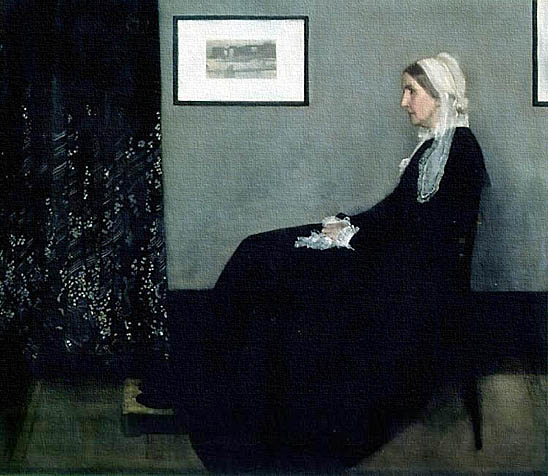
Whistler's painting The White Girl (1862) caused controversy when exhibited in London and, later, at the Salon des Refusés in Paris. The painting epitomizes his theory that art should essentially be concerned with the beautiful arrangement of colors in harmony, not with the accurate portrayal of the natural world.
The White Girl: 1862
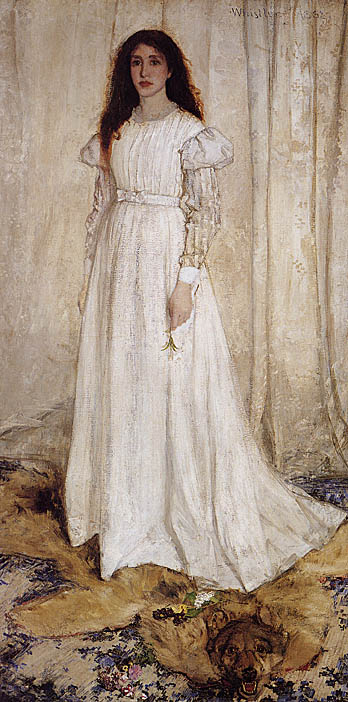
In the 1870's Whistler painted full length portraits of F.R. Leyland and his wife. Leyland subsequently commissioned the artist to decorate his dining room; the result was Whistler's Harmony in Blue and Gold: The Peacock Room, now in the Freer Gallery of Art. The room was designed and painted in a rich and unified palette of brilliant blue-greens with over-glazing and metallic leaf, and is considered a high example of the Anglo-Japanese style. The painting was inspired by the blue and white china copied in watercolor for Sir Henry Thompson's catalogue, and from the porcelain both he and Leyland collected.
F.R. Leyland: 1870
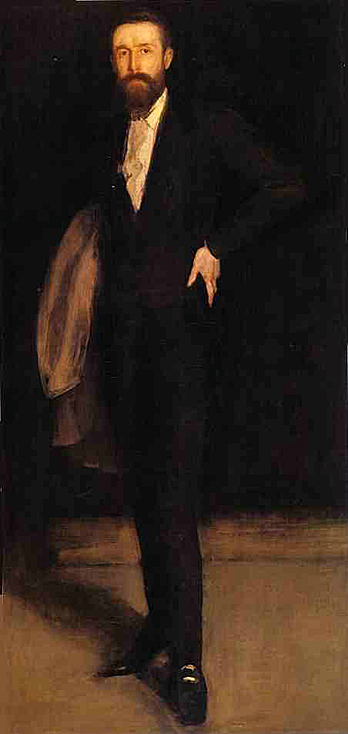
Mrs Frances Leyland: 1871-73
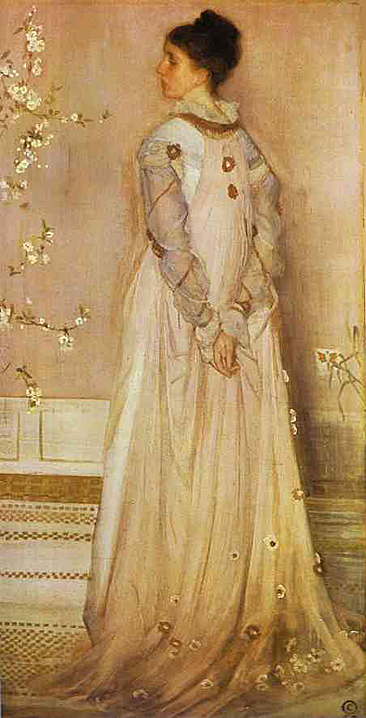
Harmony in Blue and Gold: The Peacock Room (1876-77)

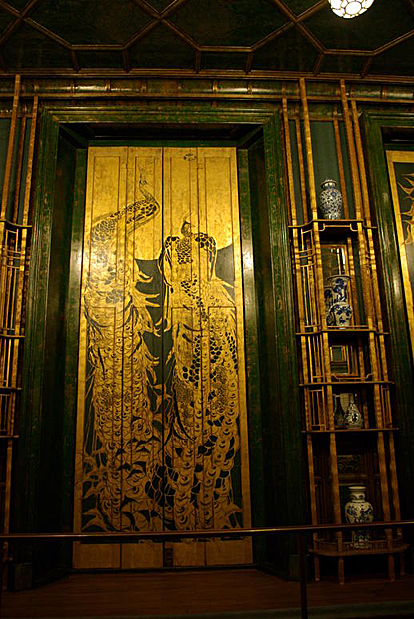
Artist and patron quarreled so violently over the room and the proper compensation for the work that their relationship was terminated. At one point, Whistler gained access to Leyland's home and painted two fighting peacocks meant to represent the artist and his patron; one holds a paint brush and the other holds a bag of money. The entire room was later purchased by industrialist and aesthete Charles Lang Freer, and installed in his collection. The published communications between Freer and Whistler reveal how Whistler's interest in those collecting his work in his native country (the United States) evolved over many decades.
Charles Lang Freer: 1902
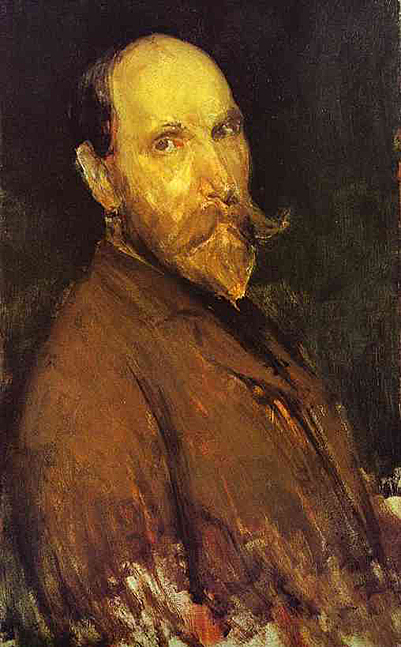
In 1877 Whistler sued the critic John Ruskin for libel after the critic condemned his painting Nocturne in Black and Gold: The Falling Rocket. Whistler exhibited the work in the Grosvenor Gallery that year alongside Edward Burne-Jones and others, and was reviewed by Ruskin in his publication Fors Clavigera on the July 2nd, 1877. Ruskin praised Burne-Jones, while he attacked Whistler:
Nocturne in Black and Gold: The Falling Rocket (1874)
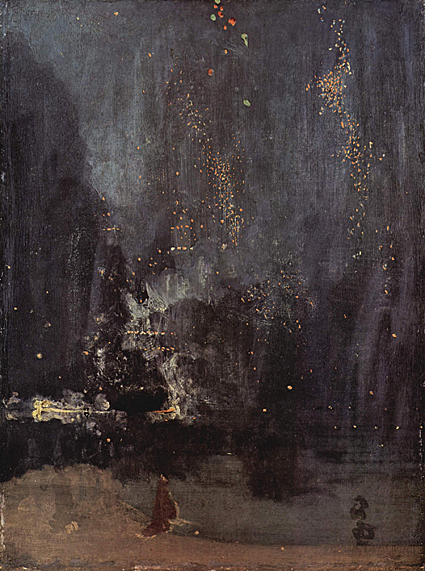
"For Mr. Whistler's own sake, no less than for the protection of the purchaser, Sir Coutts Lindsay (founder of the Grosvenor Gallery) ought not to have admitted works into the gallery in which the ill-educated conceit of the artist so nearly approached the aspect of willful imposture. I have seen, and heard, much of Cockney impudence before now; but never expected to hear a coxcomb ask two hundred guineas for flinging a pot of paint in the public's face."
The case came to trial the following year and was heard at the Queen's Bench of the High Court from November 25th to 26th 1878. The lawyer for John Ruskin, Attorney General Sir John Holker, and cross examined Whistler:
Holker: "What is the subject of Nocturne in Black and Gold: The Falling Rocket?"
Whistler: "It is a night piece and represents the fireworks at Cremorne Gardens."
Holker: "Not a view of Cremorne?"
Whistler: "If it were A View of Cremorne it would certainly bring about nothing but disappointment on the part of the beholders. It is an artistic arrangement. That is why I call it a nocturne...."
Holker: "Did it take you much time to paint the Nocturne in Black and Gold? How soon did you knock it off?"
Whistler: "Oh, I 'knock one off' possibly in a couple of days - one day to do the work and another to finish it..."
Holker: " The labor of two days is that for which you ask two hundred guineas?"
Whistler: "No, I ask it for the knowledge I have gained in the work of a lifetime."
Though suing for one thousand pounds plus costs, Whistler won a mere farthing in nominal damages. The cost of the case, together with huge debts from building his residence, "The White House" in Tite Street, Chelsea, (designed with E. W. Godwin, 1877-8) bankrupted him by May 1879 despite his despairing commercial ventures, resulting in an auction of his work, collections and house. Stansky notes the irony that the Fine Art Society of London, which had organized a collection to pay for Ruskin's legal costs, supported him in etching "The Stones of Venice" (and in exhibiting the series in 1883) to recoup himself. He published his account of the trial in the pamphlet Whistler v. Ruskin: Art and Art Critics in December 1878, soon after the trial.
"The White House" in Tite Street, Chelsea
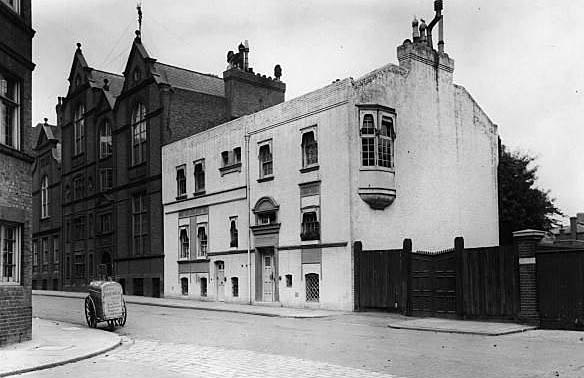
Circa 1877: The 'White House', Tite Street, Chelsea, London, former home of American artist James Abbott McNeill Whistler. The house was designed by architect Edward William Godwin and built in 1877. (Photo by Hulton Archive/Getty Images)
After the Ruskin trial, everything he mentioned or wrote about his work, and especially everything he told his biographers was done in a way in which he could dissociate himself from the English school of painting. His main purpose was to lose any relations he had with the couple of enemies he had made among the Royal Academicians, and the artists who he had been close to during the 1860's. Despite his attempts to give the notion that he did not belong to any school, he is without a doubt one of the few Victorian painters who is known for revitalizing the 'grand manner' of British painting.
A supremely gifted engraver, Whistler produced numerous etchings, lithographs, and dry-points. His lithographs, some drawn on stone, others drawn directly on "lithographie" paper, are perhaps half as numerous as his etchings. Some of the lithographs are of figures slightly draped; two or three of the very finest are of Thames subjects - including a "nocturne" at Limehouse; while others depict the Faubourg Saint-Germain in Paris, and Georgian churches in Soho and Bloomsbury in London. The etchings include portraits of family, mistresses, and intimate street scenes in London and Venice.
Etchings and Lithographs of Whistler
Afternoon Tea: 1897
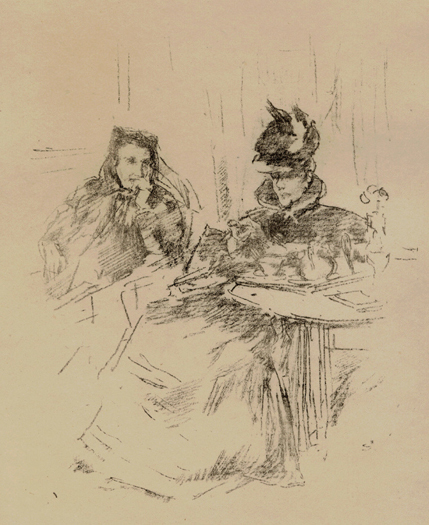
Afternoon Tea is a double portrait of Whstler's mother-in-law, Frances Birnie Philip, and her daughter, Ethel Whibley.
Annie: 1897
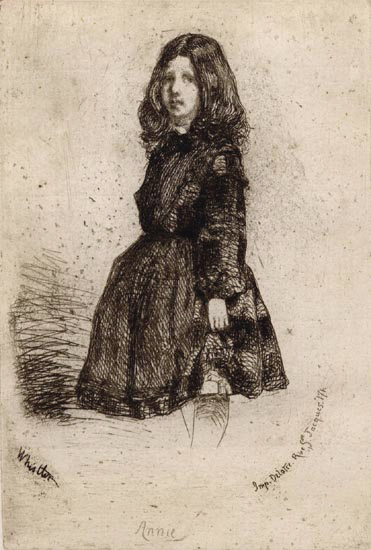
Annie Haden was the eldest daughter of Whistler's half-sister, Deborah and the famous etcher, Sir Francis Seymour Haden. At the time of this etching, she would have been about 9 or 11 years old.
Annie Seated: 1858
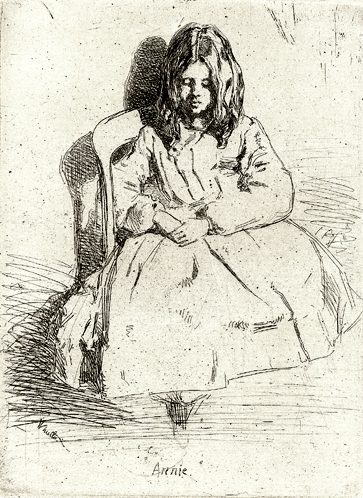
One of the most charming of Whistler's early etchings, this portrait study of Annie Haden was etched around 1859. The etching is not to be found among the Twelve Etchings from Nature, having only been available as an independent print. Annie Haden was the eldest daughter of Whistler's half-sister, Deborah and the famous etcher, Sir Francis Seymour Haden. At the time of this etching, she would have been about 10 or 12 years old.
Billingsgate: 1859

For many centuries Billingsgate was the main wharf for the mooring of fishing vessels and landing their cargoes. Corn, malt, salt and fish were landed as early as the 13th century. In 1699 an Act of Parliament was passed making it "a free and open market for all sorts of fish whatsoever". Until the 19th century, fish was sold from stalls and sheds around the dock at Billingsgate. As trade increased, the first purpose-built Billingsgate Market building was built on Lower Thames Street in 1850. Billingsgate is associated with the famous London fish market.
Cadogan Pier: 1859
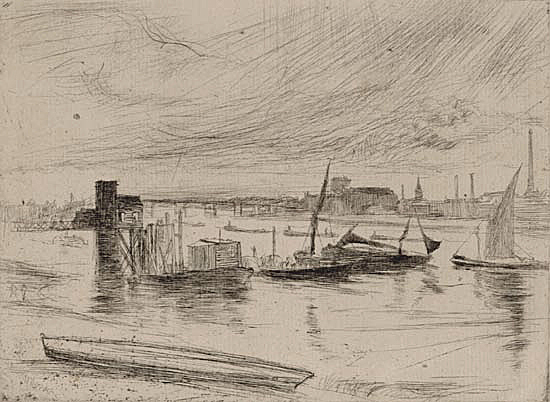
Cadogan Pier was built in the nineteenth century, by Lord Cadogan. In the shadow of Albert Bridge, and opposite Battersea Park, it is one of London’s best moorings.
Fulham: 1879
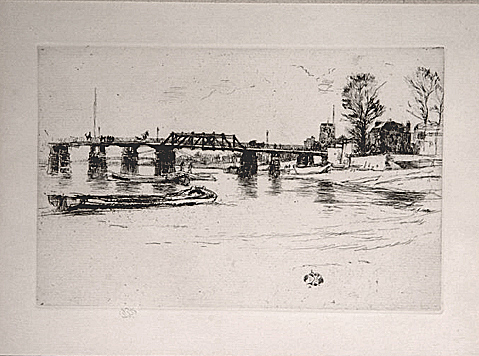
Printed on the full sheet of antique cream paid paper countermarked '1804'. Signed with the butterfly in the plate and in pencil.
The Lime-Burner: 1859
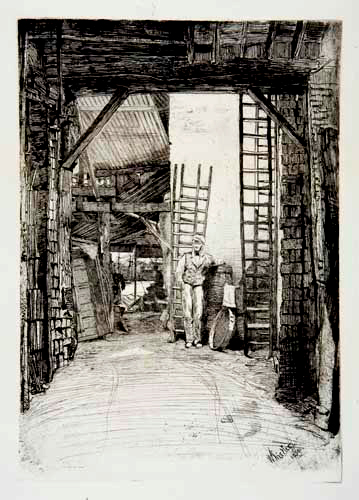
In the Royal Academy Summer Exhibition of 1859, this etching was described as " W. Jones, lime-burner, Thames Street (943)." When published in" A Series of Sixteen Etchings of Scenes on the Thames and Other Subjects by James Whistler" it was entitled (9) The Lime-Burners.
Old Hungerford Bridge: 1861

Old Hungerford Bridge is one of two footbridges on either side of the Charing Cross railway bridge across the river Thames. This linked the south bank with Hungerford Market on the north side. Whistler probably etched the plate in the winter of 1860, when the Brunel Bridge was being demolished to make way for Charing Cross railway bridge.
The suspension chains, some of which are shown being taken down, were re-used to complete Clifton Suspension Bridge in Bristol, also designed by Brunel. This etching anticipates Whistler’s move to an aesthetic approach, concentrating on simple lines and shapes to convey the scene. He has included a number of different river craft: steamboats, Thames barges, lighters and a hay barge. Figures can be seen working high up on the bridge.
Rotherhithe: 1860
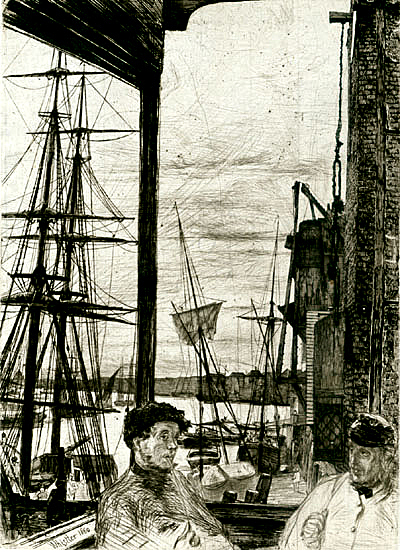
Rotherhithe was made on the balcony of the Angel Inn at Rotherhithe, looking northwest toward the City; the dome of St. Paul's is visible on the horizon at the far left.
Seymour Standing Under a Tree: 1856-57
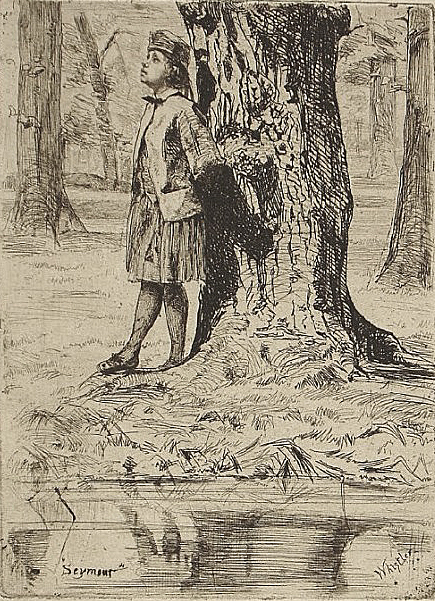
Seymour Standing Under a Tree is a portrait of Arthur Charles Haden, brother to Annie, and the son of Whistler's brother-in-law, the famous etcher, Sir Francis Seymour Haden. Whistler, with Haden, pioneered a new style of etching that broke away from the Victorian tradition of highly finished narrative prints in which etched work filled the entire frame of the image. These two men are considered to have been the prime force behind the British Etching Revival.
Thames Police (Wapping Wharf): 1859
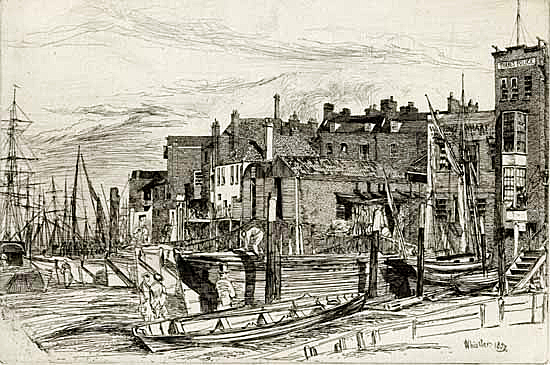
Crowded with old riverside buildings of Wapping, the viewpoint is taken from the water’s edge, looking at masts of sailing ships on the left and a row of river craft anchored on the right. The small skiffs, or rowing boats, of the Marine Police are shown pulled up on the shore at Wapping Wharf. Whistler has shown the old timber frame buildings, brick and stone work, ships’ masts, old boats and river shoreline.
Thames Warehouses: 1879
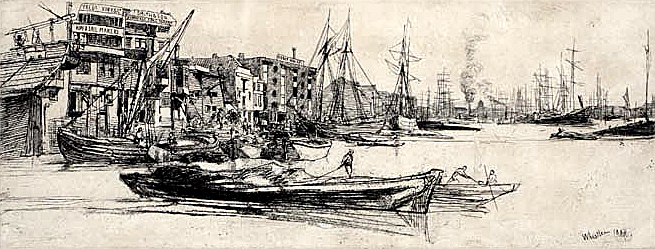
A very rich impression printed on tissue laid paper with full margins.
Vauxhall Bridge: 1861
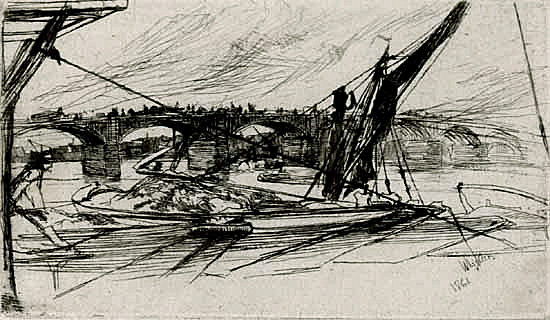
Vauxhall Bridge crosses the River Thames in central London.
La Vieille aux Loques: 1858

From the French Set (Douze Eaux-Fortes d'après Nature.) A very rich impression on pale blue laid paper with full margins and a partial Strasbourg Lily countermark.
Whistler's influence was significant, and has been the subject of museum exhibitions and publications. A trip to Venice in 1880 to create a series of etchings not only reinvigorated Whistler's finances, but also re-energized the way in which artists and photographers interpreted the city. His tonalism had a profound effect on many American artists, including John Singer Sargent and William Merritt Chase. Famous protégés included Oscar Wilde and impressionist painter Walter Sickert; Whistler fell out with both Wilde and Sickert. He successfully sued Sickert in the 1890's over a minor legal issue in France. When Wilde was publicly acknowledged to be a homosexual in 1895, Whistler openly mocked him. Another significant influence was upon Arthur Frank Mathews, whom Whistler met in Paris in the late 1890's. Mathews took Whistler's Tonalism to San Francisco, spawning a broad use of that technique among turn of the century California artists.
Once, after he had suffered a heart attack, a Dutch newspaper incorrectly reported Whistler dead. He wrote to the newspaper, saying that reading his own obituary induced a "tender glow of health".
The operetta Patience pokes fun at the Aesthetic movement, and the lead character of Reginald Bunthorne is often identified as send-up of Oscar Wilde. In reality Bunthorne seems to be an amalgam of several prominent artists, writers and Aesthetic figures. Bunthorne wears a monocle and has prominent white streak in his dark hair, as did Whistler.
Whistler published two books which detailed his thoughts on life and art: Ten O'Clock Lecture (1885), and The Gentle Art of Making Enemies (1890). He was, in turn, the subject of a contemporaneous biography by a friend: the printmaker Joseph Pennell collaborated with his wife Elizabeth Robins Pennell to write The Life of James McNeill Whistler, published in 1908.
Whistler's belief that art should concentrate on the arrangement of colors led many critics to see his work as a precursor of abstract art.
The house in which he was born is now preserved as the Whistler House Museum of Art. He is buried at St Nicholas's Church in Chiswick, London.
Whistler achieved worldwide recognition during his lifetime. In 1884 he was elected an honorary member of the Royal Academy of Fine Arts in Munich. In 1892 he was made an officer of the Legion d'Honneur in France and he became a charter member and first president of the International Society of Sculptors, Painters, & Gravers in 1898.
Various Works of James Abbott McNeill Whistler:
These are not necessarily in any thematic or chronological order.
At the Piano: 1858-59
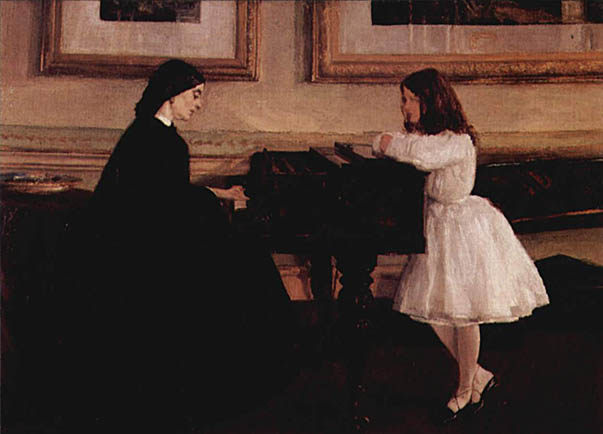
"At the Piano", Whistler's first major work, reflects the bourgeois environment in which he was raised. Yet the standard subject matter of the drawing room piano is dynamized by the composition. Whistler consciously imitated the optical effect provided by the stereoscopes popular during his day. Note the two definitively separate focal points of mother and daughter; it is impossible to focus on both simultaneously. The shallow pictorial depth pulls the viewer into the canvas, which exaggerates this stereoptical effect. It feels almost as if you were holding a book so close to your face that you can't read the words.
A Shop: 1884-90
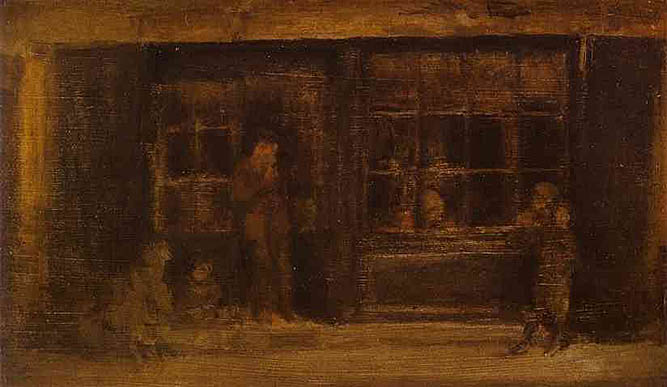
An Orange Note: Sweet Shop (1884)
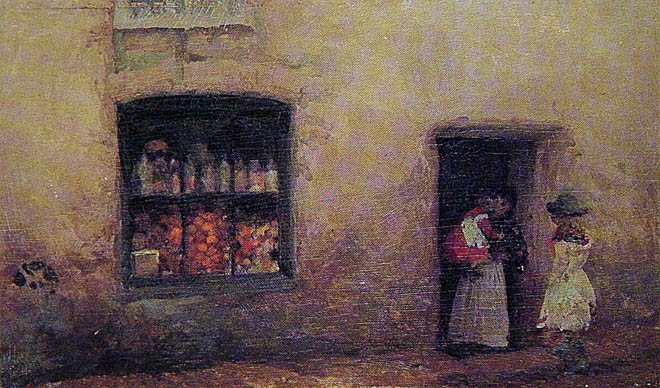
Annabel Lee: ca 1890
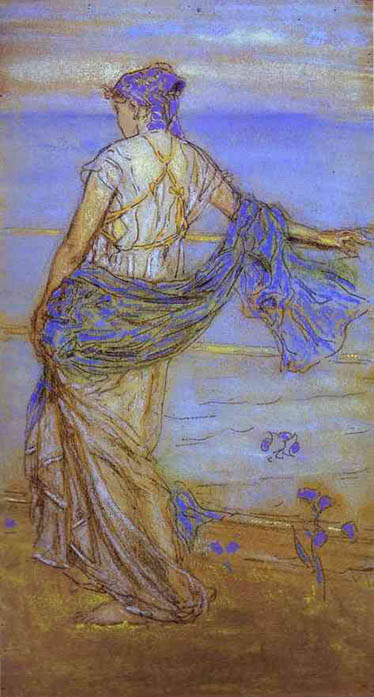
ANNABEL LEE
Edgar Allan Poe
It was many and many a year ago,
In a kingdom by the sea,
That a maiden there lived whom you may know
By the name of Annabel Lee;
And this maiden she lived with no other thought
Than to love and be loved by me.
I was a child and she was a child,
In this kingdom by the sea;
But we loved with a love that was more than love
I and my Annabel Lee;
With a love that the winged seraphs of heaven
Coveted her and me.
And this was the reason that, long ago,
In this kingdom by the sea,
A wind blew out of a cloud, chilling
My beautiful Annabel Lee;
So that her highborn kinsman came
And bore her away from me,
To shut her up in a sepulchre
In this kingdom by the sea.
The angels, not half so happy in heaven,
Went envying her and me
Yes!- that was the reason (as all men know,
In this kingdom by the sea)
That the wind came out of the cloud by night,
Chilling and killing my Annabel Lee.
But our love it was stronger by far than the love
Of those who were older than we
Of many far wiser than we
And neither the angels in heaven above,
Nor the demons down under the sea,
Can ever dissever my soul from the soul
Of the beautiful Annabel Lee.
For the moon never beams without bringing me dreams
Of the beautiful Annabel Lee;
And the stars never rise but I feel the bright eyes
Of the beautiful Annabel Lee;
And so, all the night-tide,
I lie down by the side
Of my darling- my darling- my life and my bride,
In the sepulchre there by the sea,
In her tomb by the sounding sea.
Arrangement in White and Black - Portrait of Miss Rosa Corder: 1876
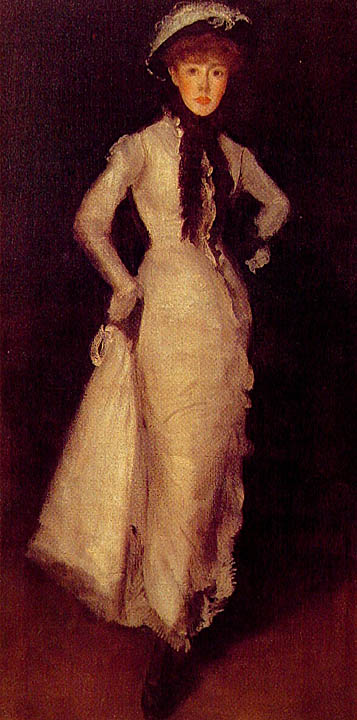
The artist Rosa Corder was the mistress of the art dealer and entrepreneur Charles Augustus Howell and the mother of his son. Howell assisted Whistler in selling his artwork, particularly his prints, in the late 1870's.
Arrangement in Yellow and Grey - Portrait of Effie Deans: 1877
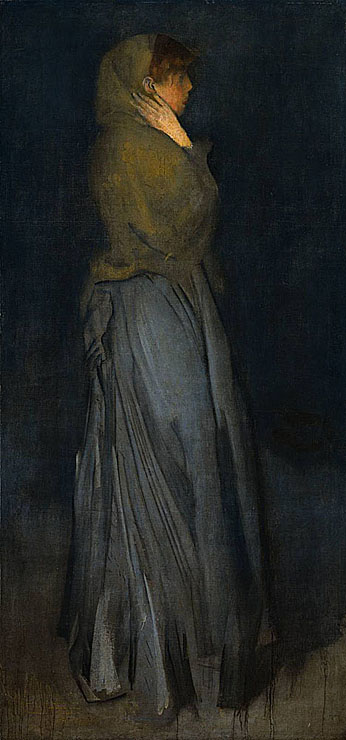
Effie Deans is one of the central characters in The Heart of Midlothian, a novel by Sir Walter Scott, written in 1818. Effie had been imprisoned on a false charge: accused of having killed her illegitimate child. When an angry crowd stormed the goal, she had an opportunity to escape. But Effie decided to stay. Prison seemed a better prospect than a life of freedom with a tarnished reputation.
At the time Whistler painted this portrait a play based on the story of Effie Deans was running at the Albion Theatre in London. Whistler may well have seen the play and been inspired by Effie's tragic fate.
Quote from Sir Walter Scott: "She sunk her head upon her hand and remained seemingly unconscious as a statue." The woman's personality and posture reflect the sentiment of the quotation. Whistler added the text some years after completing the picture at the buyer's request.
The Old Battersea Bridge (Another View): 1859

Caprice in Purple and Gold No 2 - The Golden Screen: 1864
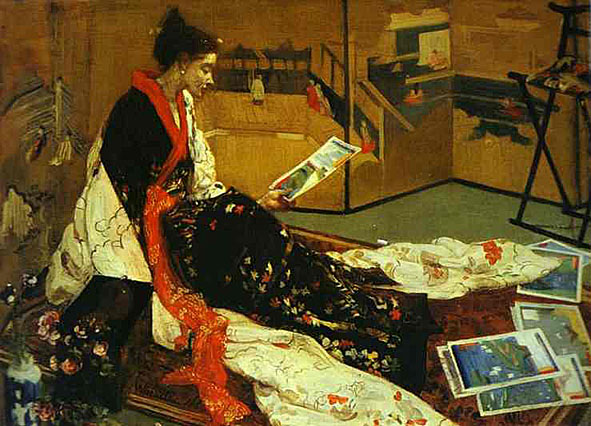
Chelsea Houses: ca 1880-87
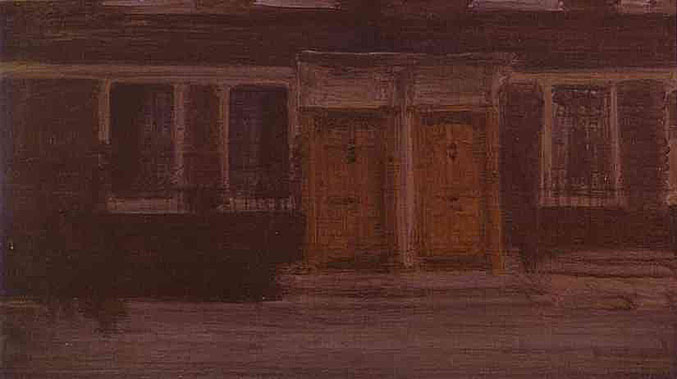
Chelsea Wharf: 1875
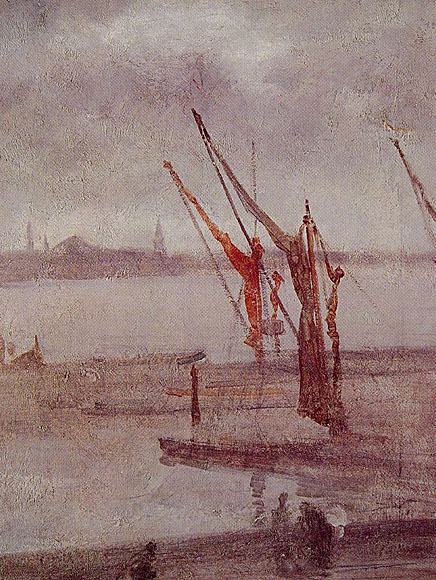
In Grey and Silver: Chelsea Wharf, the tenements and factories on the distant Battersea shoreline are transformed into a fantasy of spires and domes. A few diagonal spars enliven the quiet geometry of masts and hulls, docks and passersby.
The subtle tonal scheme is composed entirely of muted variations on the complementary colors of blue and orange. Whistler stated, "As music is the poetry of sound, so is painting the poetry of sight." In other words, various musical notes relate to a dominant key, just as various colors relate to a unifying hue in painting.
Cremorne Gardens No 2: ca 1872-77
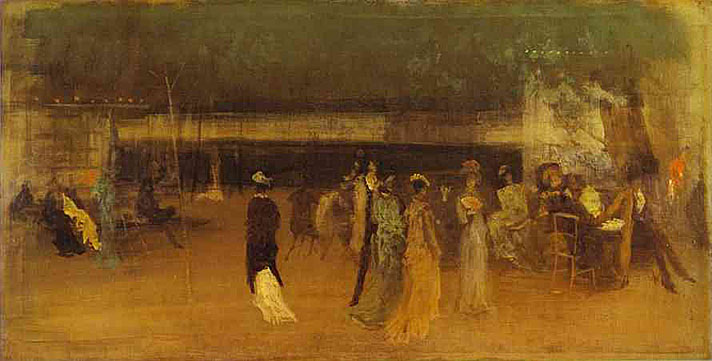
Cremorne Lights: 1872
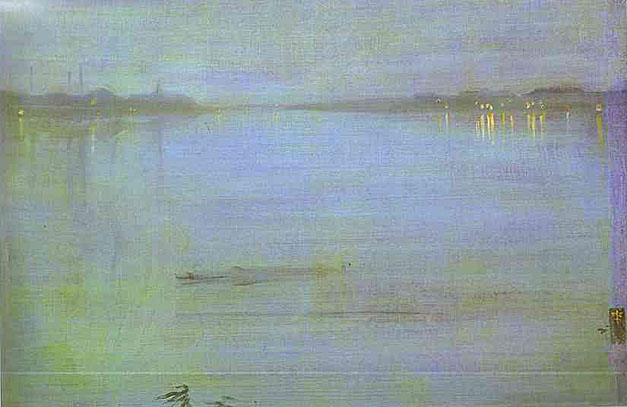
Grey and Gold: Snow in Chelsea (1876)
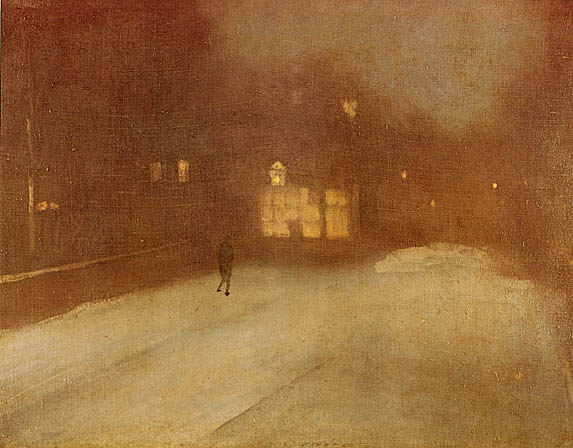
Grey and Silver: Battersea Beach (1863)

Harmony in Blue and Silver: 1865
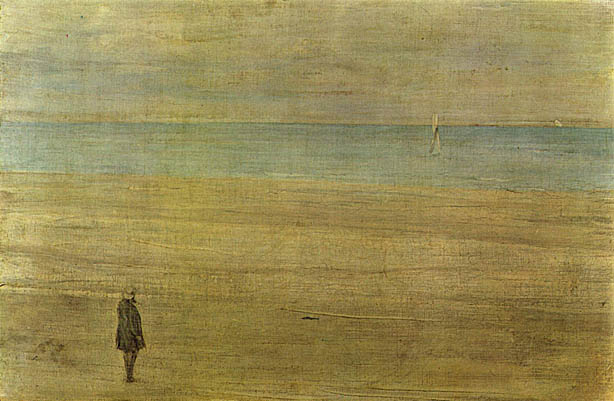
Harmony in Green and Rose: The Music Room
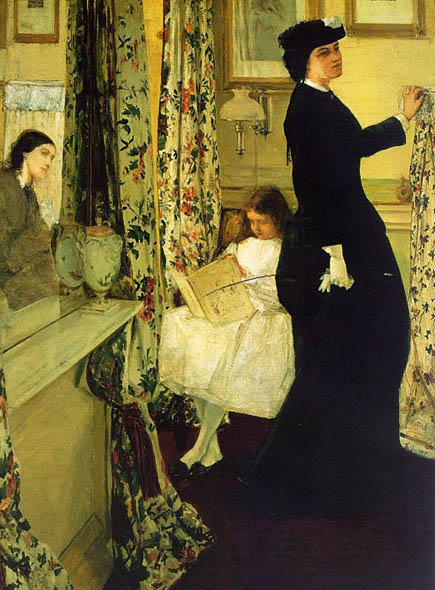
Portrait of Miss Constance Macdonald Gilchrist (1865-1946), depicted in costume as she would have appeared on the stage of the Gaiety Theatre, in the skipping-rope dance. The rope swings over her head as she steps forward with her right leg. She wears a light brown dress and satin boots with high heels.
Quoted From: Horizon Information Portal
Harmony in Grey and Green: Miss Cicely Alexander (1873)
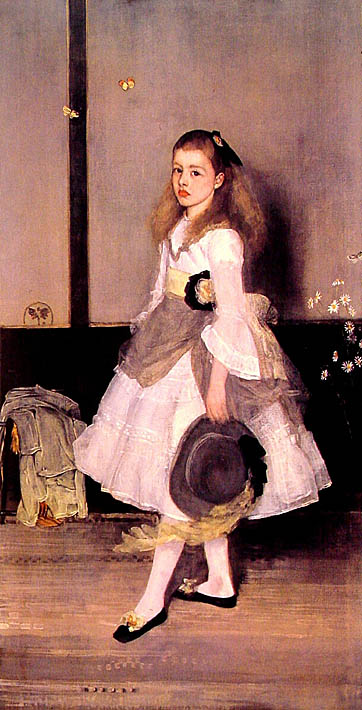
Cicely Alexander was the second daughter of the London banker and art collector W.C. Alexander. Her father was the first to buy a nocturne, and he commissioned Whistler to paint portraits of his two daughters, both of which are now in the Tate Gallery. Whistler designed the dress for the portrait.
Harmony in Red Lamplight: 1886
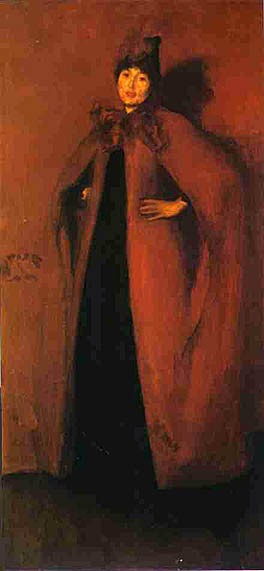
Harmony in Yellow and Gold: The Gold Girl Connie Gilchrist

Portrait of Miss Constance Macdonald Gilchrist (1865-1946), depicted in costume as she would have appeared on the stage of the Gaiety Theatre, in the skipping-rope dance. The rope swings over her head as she steps forward with her right leg. She wears a light brown dress and satin boots with high heels.
Quoted From: Horizon Information Portal
Head of a Peasant Woman: 1855-58

Head of Old Man Smoking: ca 1858

Joanna Hiffernan: ca 1860
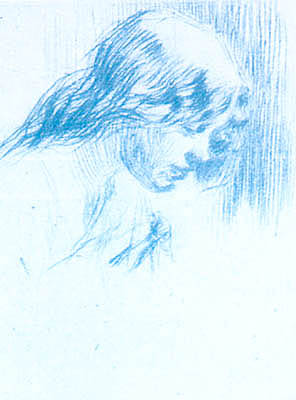
La Belle de Jour: ca 1885
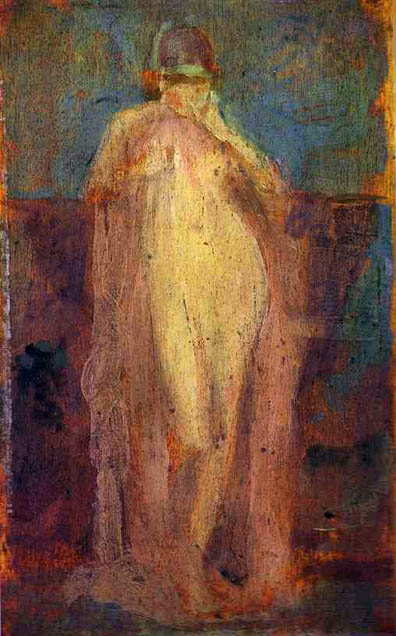
London Bridge: 1885
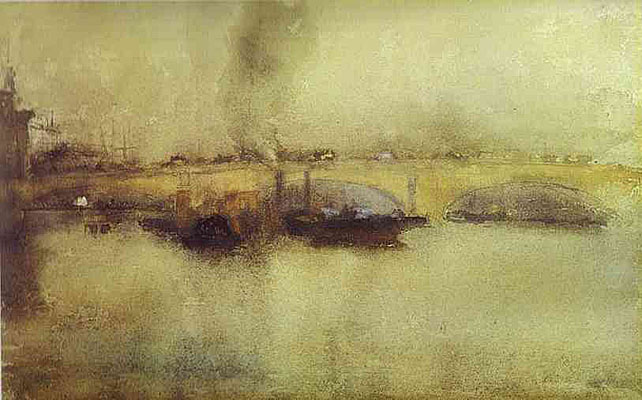
Maud Franklin: ca 1875
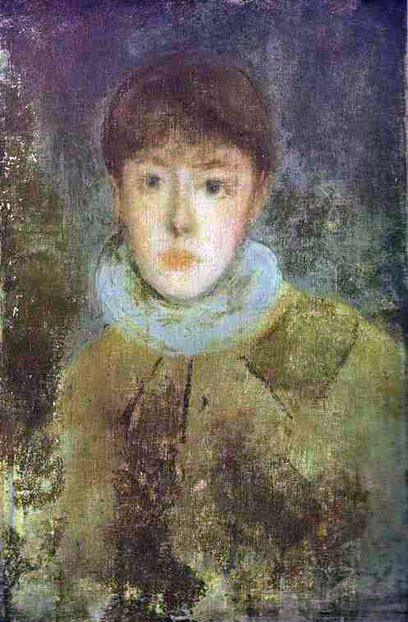
Maud Franklin, the daughter of a cabinetmaker and upholsterer, was born in Bicester, near Oxford, on 9 January 1857. In the late 1870's, she posed to Whistler for several etchings and portraits, including 'Arrangement in White and Black'. She had two daughters by Whistler, one, Ióne, probably born in 1877, a second, registered as Maud McNeill Whistler Franklin, born on 13 February 1879. Maud accompanied Whistler to Venice in 1879-80. She painted herself in the manner of her lover. After Whistler married Beatrice Godwin in 1888, Maud lived in Paris. She married an American, Richard H. S. Abbott, and lived near Cannes until her death, probably in 1941. She refused Whistler's biographers to give any information concerning her relationship with him.
Miss Rosalind Birnie Philip Standing: ca 1897
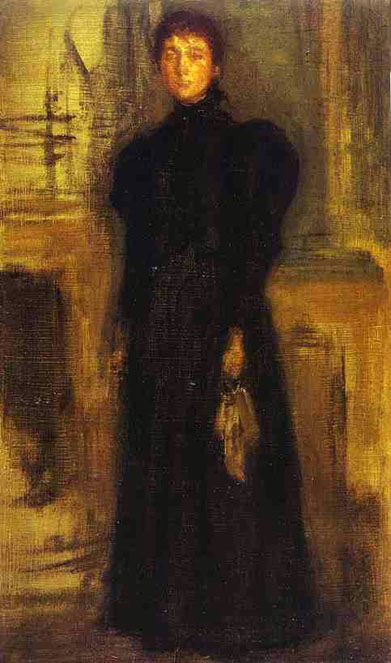
Rosalind, the daughter of the sculptor John Birnie Philip, was 22 when her elder sister Beatrice, Whistler's wife, died in 1896. Whistler then made her his ward and executrix; she acted as his secretary until his death in 1903. Thereafter she became something of a jealous guardian of Whistler's memory. She presented an important group of paintings and drawings to the University of Glasgow in 1935, and followed this, in 1955 and 1958, with a bequest which consisted of the rest of the Whistler estate, including some 6000 letters, ledgers, books, catalogues, etc. She posed for several drawings and lithographs by him, as well as five paintings, three of which are now in the Hunterian Art Gallery.
Mother of Pearl and Silver: The_Andalusian (1888-1900)
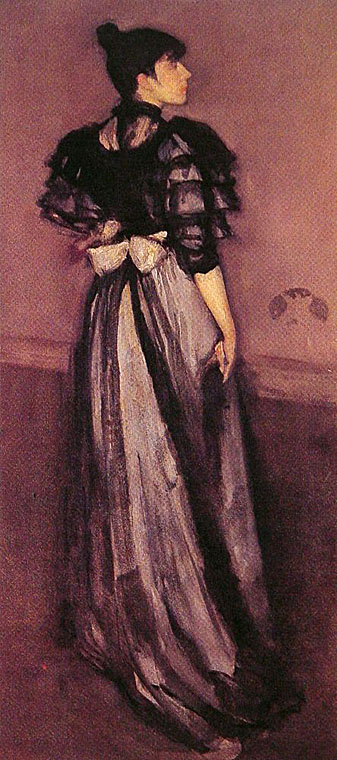
Mrs Charles Wibley Reading: 1894
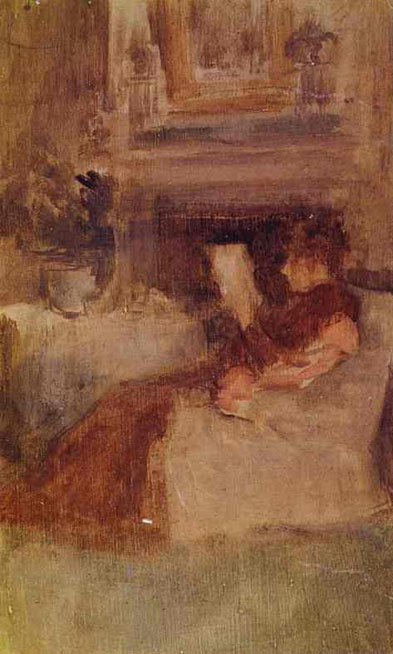
Nocturne Blue and Gold: Old Battersea Bridge (ca 1872-75)
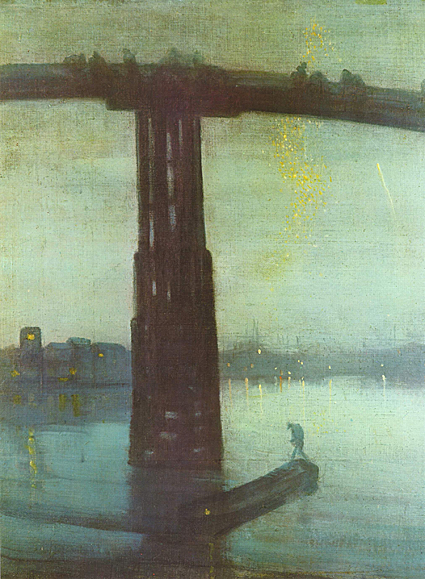
This painting is dominated by Battersea Bridge, with Chelsea Old Church and the lights of the newly built Albert Bridge just visible in the background. The Thames has long signified the condition and power of London.
Whistler, however, does not portray the riverside crowded with factories, warehouses, wharves and mills, but the atmospheric effects of the water in the evening. He wrote 'when the evening mist clothes the riverside with poetry… tall chimneys become campanili (bell towers) and the warehouses are palaces in the night and the whole city hangs in the heavens and fairy land is before us'.
Nocturne in Blue and Gold: Valparaiso Bay (1866)
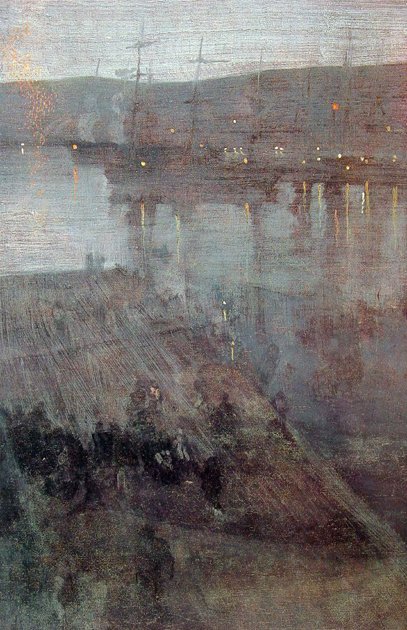
Nocturne in Blue and Silver: 1871-72
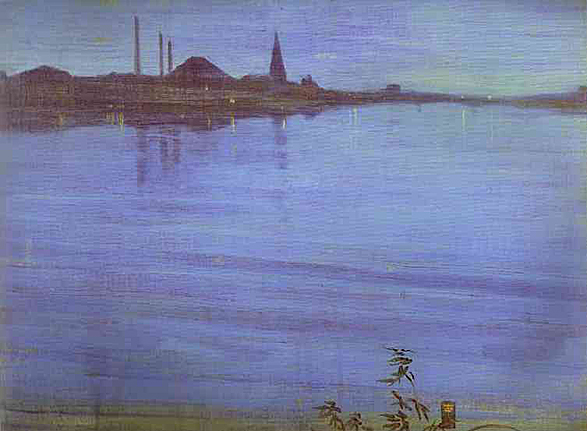
Nocturne in Blue and Silver: The Lagoon Venice (1879-80)
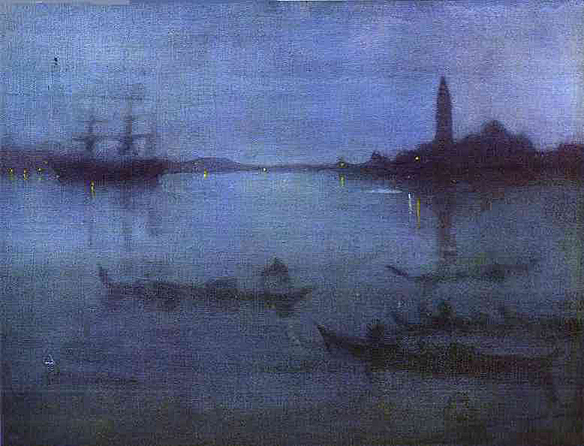
Nocturne in Gray and Gold: Westminster Bridge (ca 1871-1874)
.jpg)
Nocturne in Pink and Grey: Portrait of Lady Meux (1881-1882)

Nocturne Trafalgar Square Chelsea Snow: 1876
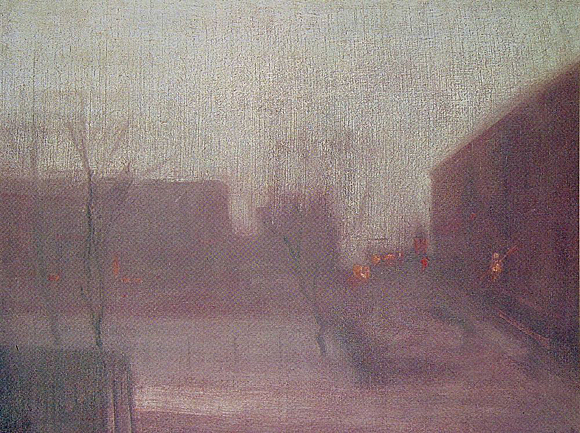
Pink Note: The Novelette (1884)

The expressiveness of Whistler's brushwork is evident in this watercolor. He suggested the fall of the curtains through vertical sweeps of the brush and the carpet using horizontal strokes. The unmade bed was painted using dabs and streaks of color. Whistler concentrated attention on some areas of the picture, leaving others only roughly suggested. For example, the face of the girl absorbed in her book and the picture and fans above the fireplace were very delicately painted, while the little table was left undefined. The paper shows through here, showing how little worked this area was. Whistler's pictures were criticized at the time because of their apparent lack of finish. However, Whistler cleverly used the bare paper to give white highlights rather than using white paint. His varied brushstrokes also gave the picture a vibrancy and freshness.
Portrait of Arthur J Eddy: 1894
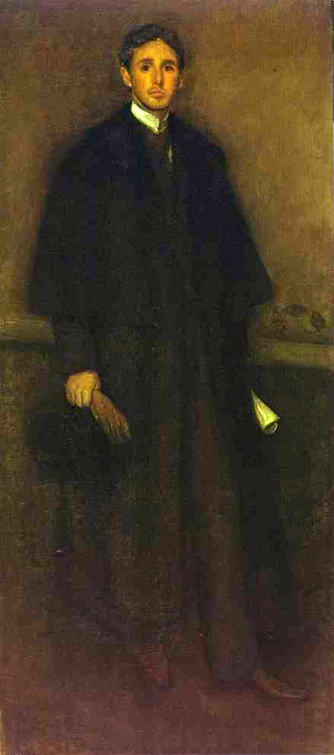
The Chicago lawyer Arthur J. Eddy was an early collector of cubist and abstract art. He commissioned his portrait from Whistler in 1893, and it was painted in six weeks in his Parisian studio, 1894.
Portrait of Lady Archibald Campbell: 1882-84

Janey Sevilla Callander of Craigforth, Stirling, and Ardkingglass, Argyll, married the second son of the eighth Duke of Argyll in 1869. Her patronage significantly assisted Whistler's position in London society after his return from Venice in 1880. In her turn, Lady Archibald was much influenced by Whistler's color theories, as expressed in her book Rainbow Music or The Philosophy of Harmony in Color-Grouping, published in 1886. Whistler painted three portraits of her.
Portrait of Miss Milly Finch: ca 1885
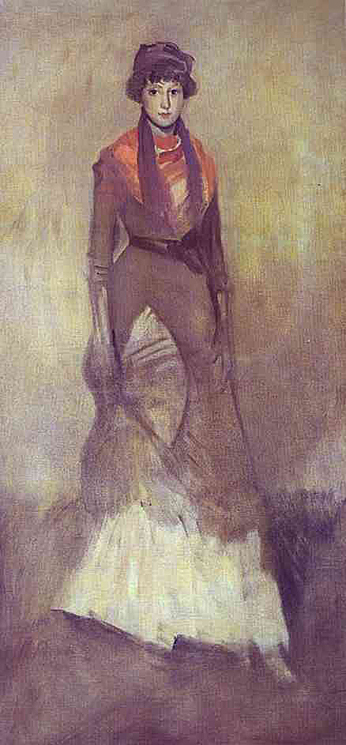
Portrait of Miss Rosa Corder: ca 1876

The artist Rosa Corder was the mistress of the art dealer and entrepreneur Charles Augustus Howell and the mother of his son. Howell assisted Whistler in selling his artwork, particularly his prints, in the late 1870's.
Portrait of Theodore Duret: 1883
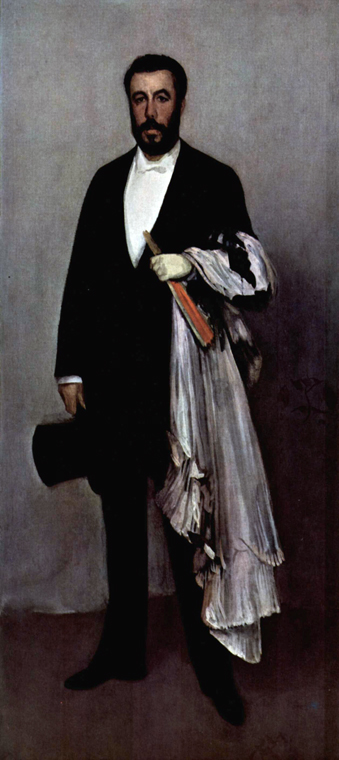
Theodore Duret (1838-1927), heir to a firm of Cognac dealers, was a collector, orientalist, and art critic. An early champion of Courbet, Manet, and the Impressionists, he was introduced to Whistler by Manet. He posed for this portrait in 1883 at Whistler`s London studio at 13 Tite Street. At Duret`s request, Whistler painted him in full evening dress, but Whistler suggested that he hold a pink domino, an addition necessary to the decorative arrangement of the composition. Whistler worked on the portrait over a long period of time, even though the finished work ultimately looks like a rapid sketch. Acclaimed when exhibited at the Paris Salon of 1885, it was ranked by many as the best portrait of Duret painted by any of the great Realist artists of the period.
Portrait of Thomas Carlyle: 1873
_1873.jpg)
Thomas Carlyle (1795-1881) is a Scottish historian, essayist and intellectual, born in Ecclefechan in Dumfriesshire. He was educated at Ecclefechan village school, Annan Academy and Edinburgh University, where he studied arts and mathematics. After graduating in 1813 he worked as a teacher. In 1818, Carlyle returned to Edinburgh and engaged himself with private tutoring and translations of different authors from German and French. In 1826, he married Jane Baillie Welsh and started to write articles and essays for the Edinburgh Review. In 1834, the Carlyle's moved to London, where Thomas spent the rest of his life. Here he completed 'The French Revolution' (1837), 'On Heroes', 'Hero Worship and the Heroic in History' (1841), 'Past and Present' (1843), a six-volume History of … 'Frederick the Great' (1858-65), 'The Early Kings of Norway' (1875) et al. In 1866 he was installed as Lord Rector of Edinburgh University. He was buried at his own wish in Ecclefechan.
Portrait of Whistler with Hat: 1858
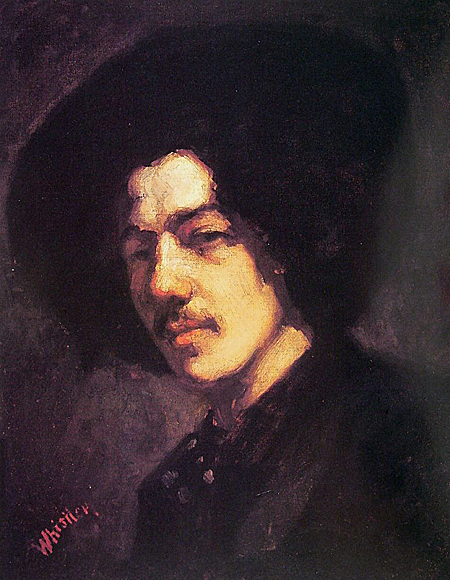
Self Portrait: 1895-1900
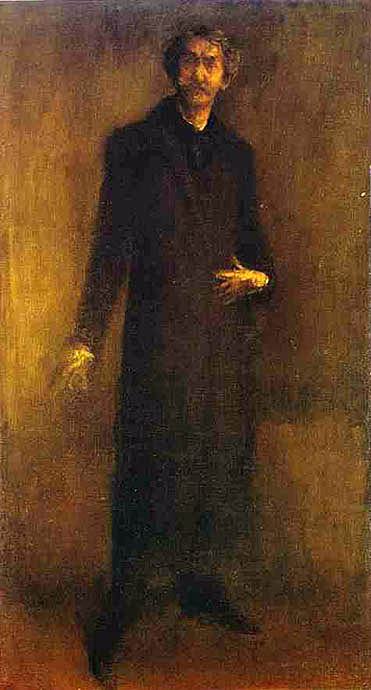
Symphonie in White No 2 (1864)
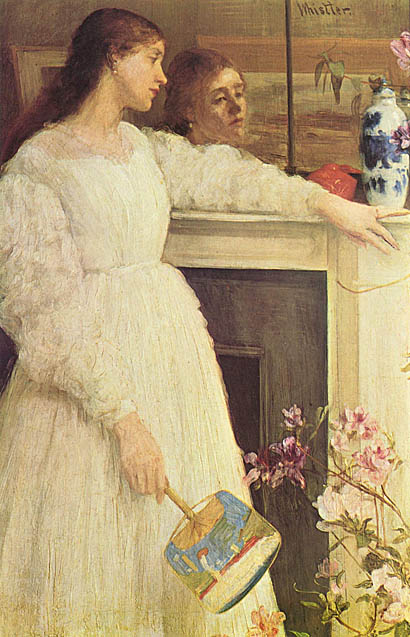
This picture was exhibited at the Royal Academy in 1865 as 'The Little White Girl'. It shows a young woman, dressed in white, leaning against a mantelpiece and gazing dreamily into a mirror. She is captured in a moment of deep contemplation. Her face is reflected in the mirror and silhouetted against a seascape, reinforcing the dream-like atmosphere. The reflected image is sad and careworn, and one is tempted to draw some kind of link with the wedding ring so prominently displayed on her left hand. Whistler may also have intended to evoke Velasquez's Rokeby 'Venus' (National Gallery, London), where the reflection of the woman's face is similarly at odds with her own idealized image.
The poet Swinburne was so inspired by Whistler's picture that he composed a verse ballad, 'Before the Mirror', in response. It was intended to complement, rather than explain the picture:
Glad, but not flushed with gladness,
Since joys go by;
Sad, but not bent with sadness,
Since sorrows die;
Deep in the gleaming glass
She sees all past things pass,
And all sweet life that was lie down and lie.
(Algernon Swinburne, Poems and Ballads, London 1866)
Whistler was delighted with the poem and had it printed on gold paper and pasted onto the frame. In this way he hoped to reinforce the picture's theme of reverie and regret.
The model for the picture was Whistler's mistress, Jo Hiffernan, and the location the house that they shared in Lindsey Row, Chelsea. She is holding a Japanese fan of the type made for the European market. Whistler was fascinated by Japanese art and culture and collected Japanese objects from an early date. The fan, the red pot and blue and white vase on the mantelpiece, and the spray of pink azalea not only give the picture a Japanese feel, they provide brilliant color notes against the neutral background of black, white and cream. Pictures hanging in the room are reflected in the mirror, their frames creating a series of right angles which are echoed by the fireplace and the mirror itself, dividing and compartmentalizing the picture like a Japanese print.
Symphony in Blue and Pink: ca 1870
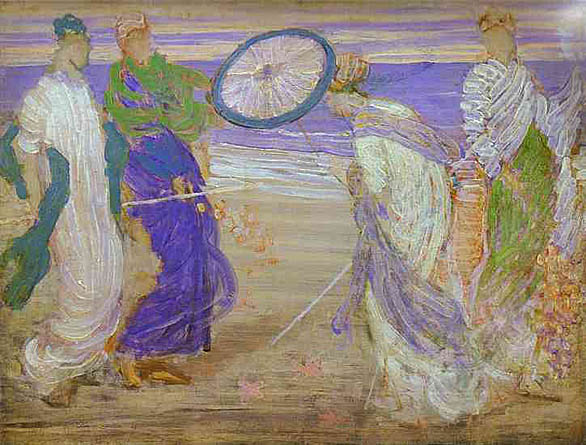
Symphony in Grey and Green: The Ocean (1866-72)
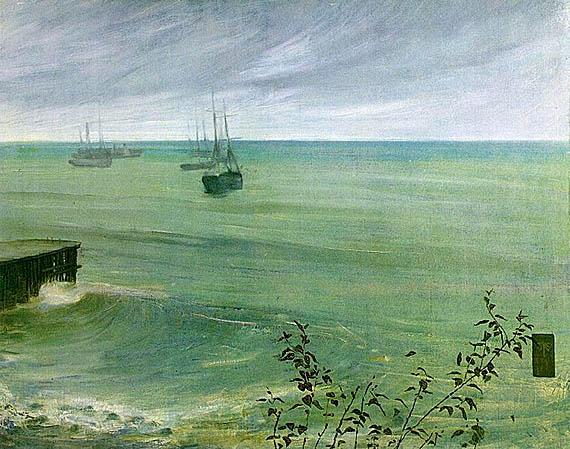
Symphony in White No 3 (1866)
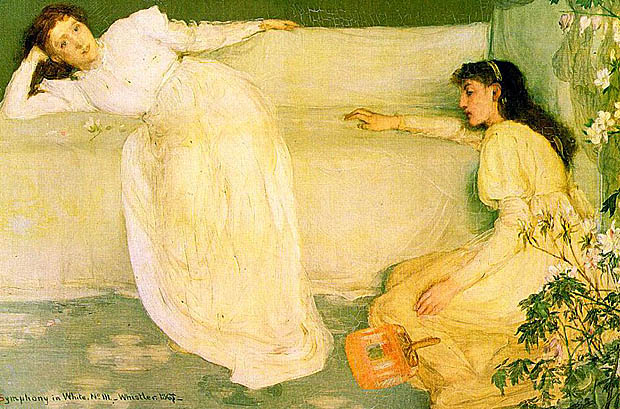
The model was his red-haired Irish mistress, Joanna Hiffernan, who posed in Paris in 1861 for 'The White Girl', later called Symphony in White, No. 1: 'The White Girl' (YMSM 38). Rejected by the Royal Academy in 1862, it hung in a London gallery. In the first of many published letters, Whistler denied that it represented Wilkie Collins's 'Woman in White' but simply represents a girl dressed in white in front of a white curtain' (Athenaeum, 5 July 1862). Rejected also by the Paris Salon in 1863, it was, with Manet's Déjeuner sur l'herbe, the 'succès de scandale' of the Salon des Refusés. Paul Mantz in the Gazette des Beaux Arts (July 1863) called it a 'Symphonie du blanc'. Whistler adopted this nomenclature publicly for Symphony in White, No. 3 (YMSM 61) at the Royal Academy in 1867.
Symphony in White No 3 (1866)

The model was his red-haired Irish mistress, Joanna Hiffernan, who posed in Paris in 1861 for 'The White Girl', later called Symphony in White, No. 1: 'The White Girl' (YMSM 38). Rejected by the Royal Academy in 1862, it hung in a London gallery. In the first of many published letters, Whistler denied that it represented Wilkie Collins's 'Woman in White' but simply represents a girl dressed in white in front of a white curtain' (Athenaeum, 5 July 1862). Rejected also by the Paris Salon in 1863, it was, with Manet's Déjeuner sur l'herbe, the 'succès de scandale' of the Salon des Refusés. Paul Mantz in the Gazette des Beaux Arts (July 1863) called it a 'Symphonie du blanc'. Whistler adopted this nomenclature publicly for Symphony in White, No. 3 (YMSM 61) at the Royal Academy in 1867.
The Artist's Studio: ca 1865

The 'Artist's Studio' is one of Whistler's first Japanese-inspired compositions. He portrayed an elongated figure dressed in oriental costume, and included blue and white porcelain in the background. He used a model who posed for many of his paintings. He depicted himself, wearing the long-sleeved waistcoat in which he usually painted, holding the small palette with raised edges to keep the liquid pigment from running off.
The Balcony: 1864-70

The Beach at Selsey Bill: 1865

The Blue Wave Biarritz: 1862
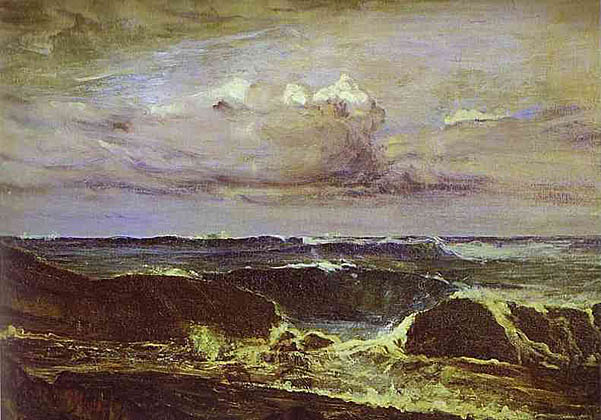
The Coast of Brittany: 1861
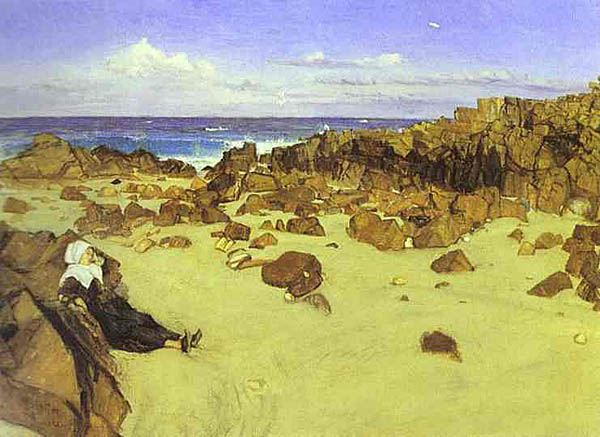
The Duet: ca 1878
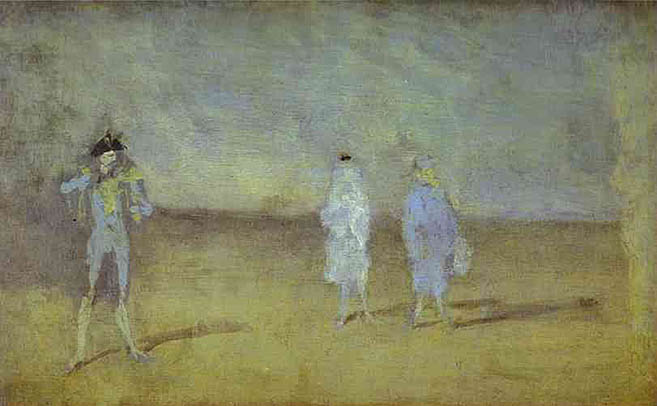
The Gold Scab: 1879
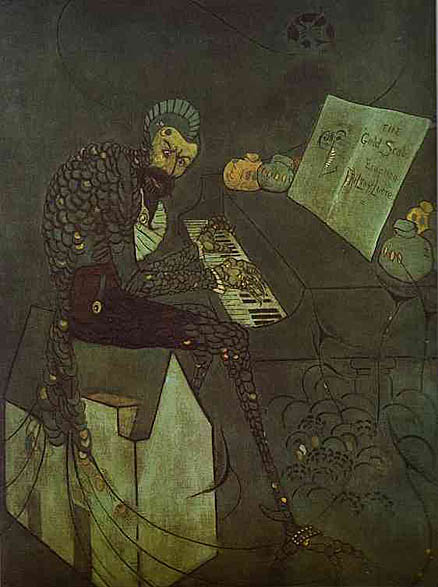
The Gold Scab shows Leyland as a hideous peacock sitting on Whistler’s White House, playing the piano.
The Grey House: 1889
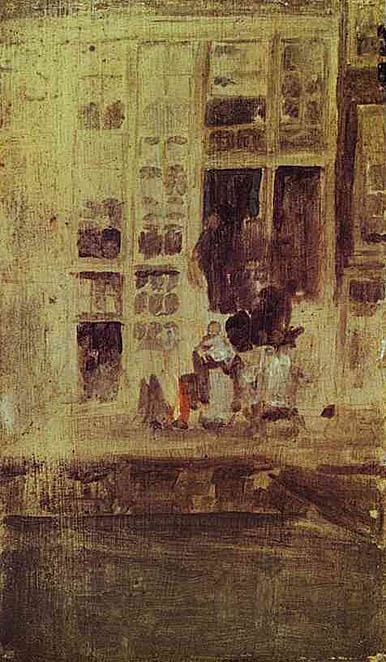
The Hotel Courtyard Dieppe: 1885
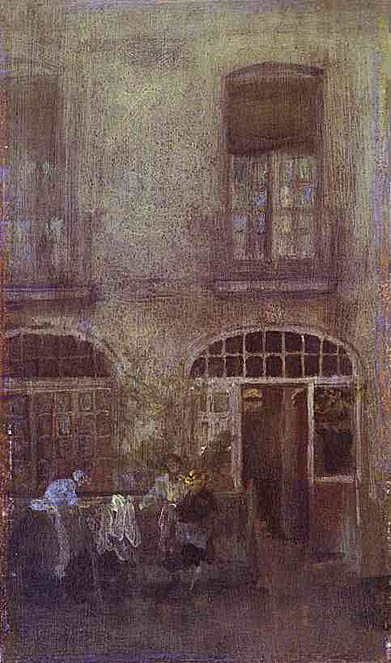
The Lange Lijzen of the Six Marks: 1864

The model for the picture was Whistler's mistress, Joanna Hiffernan, called Jo. For a few years, this beautiful, red-haired Irishwoman managed Whistler's affairs, keeping his house and assisting him with the sale of his work. To give herself respectability, she called herself Mrs. Abbott; her drunken father also referred to Whistler as 'me son-in-law'. She sat for many of his pictures, including 'The Lange Lijzen of the Six Marks'.
The Last of Old Westminster: 1862

The Little Blue Girl: 1894-1901
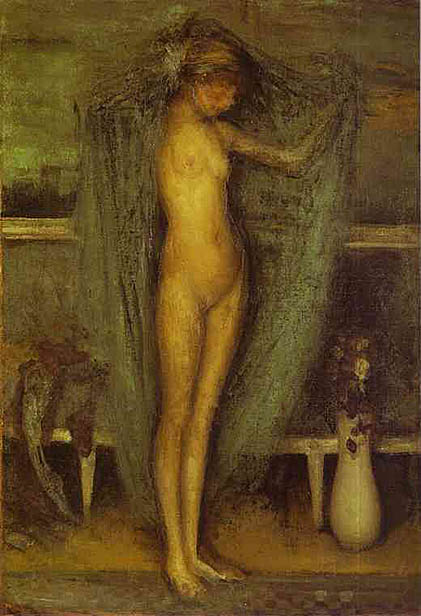
The Little Rose of Lyme Regis: 1895

When James McNeill Whistler (1834-1903) visited Lyme in 1895 he was established as a famous, if controversial, painter. He painted two famous portraits here, 'Little Rose of Lyme Regis' and 'The Blacksmith of Lyme Regis' and made a dozen lithographs. He frightened little Rose Rendall at first by saying he was going to paint her; but rewarded her for posing for him by the gift of a doll from Paris.
The Master Smith of Lyme Regis: 1895
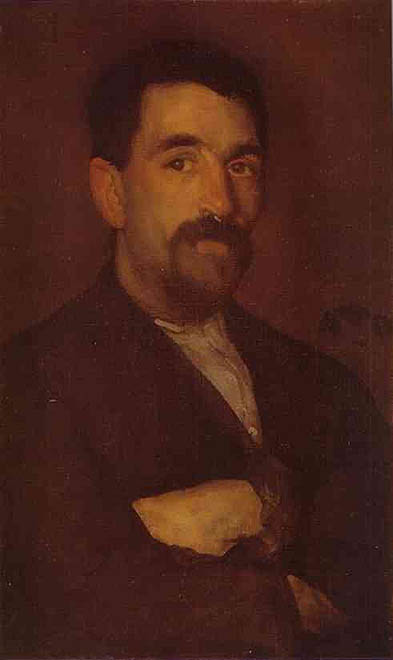
The American-born painter James McNeill Whistler, working in London and Paris, used to come and stay in Lyme, especially since its sea air seemed to be ease his wife Beatrix's cancer. ("Trixie" was the widow of the architect E. W. Godwin, who built Whistler's house; she married Whistler in 1888, and died of the cancer five years later.) He made many sketches and, in 1895, two notable portraits, "The Master Smith of Lyme Regis" and "The Little Rose of Lyme Regis" (which had also been the name of a Lyme ship three centuries earlier). Whistler's little rose was Rose Rendall, small daughter of a Broad Street grocer. He saw her from a window of the Royal Lion, and went out and told her he intended to paint her. Think what would happen to him if he did that nowadays! What happened then was that she ran away, thinking he meant to apply a coat of paint to her, like a doll. (I know at least one other person who had the same reaction when told, at the age of four, that she was going to be painted.) After it was explained to Rose that he would paint a picture of her, he rewarded her with a doll from Paris, which is now shown in the Lyme museum.
The Princess from the Land of Porcelain: 1864
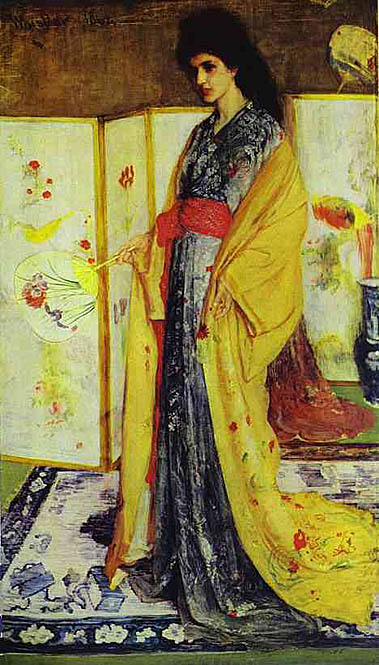
The model for the picture was Christine Spartali, daughter of a rich Greek merchant, later the Greek Consul-General in London, Michael Spartali. The picture was bought by Frederick Leyland for the dining room in his London house. Leyland had the dining room remodeled by the architect Thomas Jeckyll. The room was to hold his collection of blue and white porcelain. Whistler did not like Jeckyll's work, which, to his taste, did not harmonize with 'The Princess' and, at Leyland's permission, modified the walls. After Leyland's death, both 'The Princess' and the 'Peacock Room' itself were acquired by the American collector Charles Lang Freer, and can now be seen reassembled in the Freer Gallery in Washington.
The Staircase Note in Red: 1880
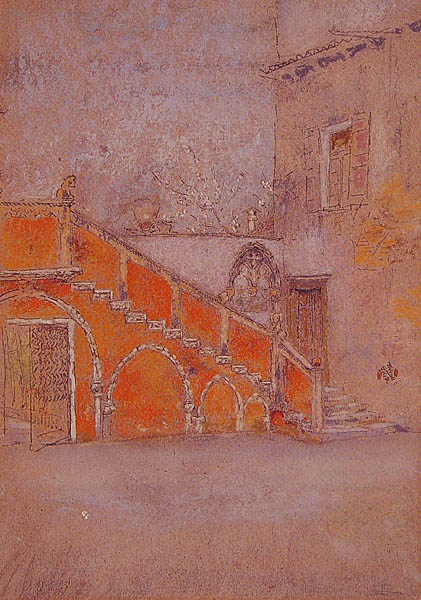
The Thames in Ice: 1860
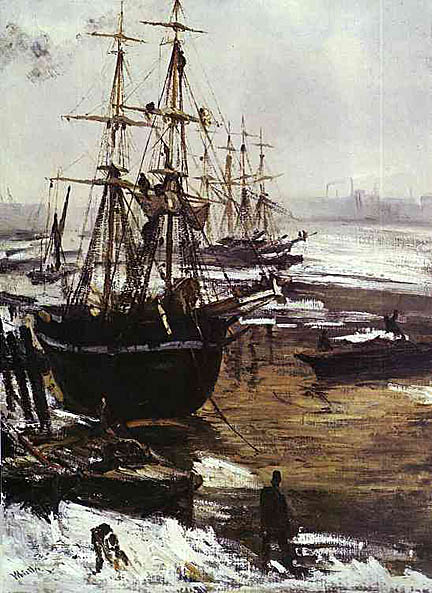
Three Girls: 1868
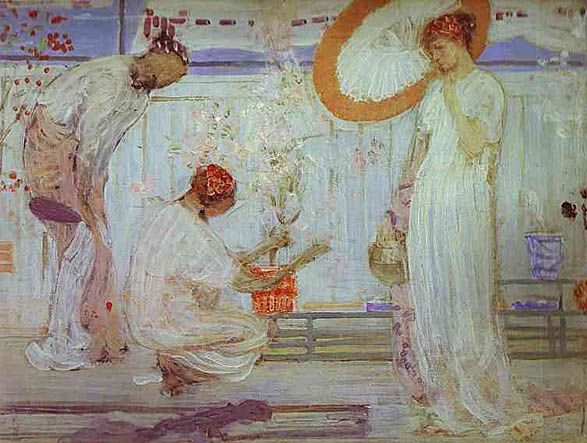
Valparaiso: 1866

Responding to the Spanish occupation of the Peruvian-owned Chincha Islands in 1864, the South American countries of Chile, Bolivia and Ecuador formed an alliance with Peru against Spain. In February 1866 Whistler left London for South America, in order to assist the Chilean cause. When he arrived in Chile on 12 March a squadron of six Spanish ships was blockading the country's main harbor, Valparaiso. In order to protect their own nationals and act as a neutral, peacekeeping force, the British, American and French governments had sent out their own fleets, which were also present. On 27 March the Spanish announced their intention to bombard the city. Although outraged by this act of aggression, the British, American and French fleets had no option but to withdraw. Whistler's picture almost certainly records the beginning of their withdrawal, on the evening of 30 March. The following day the Spanish bombarded the city, by which time Whistler had fled to the hills on horseback.
Whistler painted three other canvases in Valparaiso depicting the prelude or aftermath to the hostilities. According to Eddy, he completed this picture 'at a single sitting, having prepared his colors in advance. From this, we can gather that he was working from memory and that the overall effect was more important than accuracy of detail. We know from contemporary accounts that the Americans sent one iron-clad turreted ship and five steamers, and that the French and British fleets included frigates and gunboats. Despite this, Whistler has depicted mainly sailing ships, some of which have started to unfurl their sails, ready to move towards the open sea. The only clearly visible flag is the French tricolor in the centre of the composition, silhouetted against the gathering violet and purple clouds. Comparisons have been drawn with Manet's early marine views of 1864-5, and especially his depiction of the Battle of the Kearsarge and the Alabama (186.
When it was exhibited at the French Gallery in London in 1867 the picture was well received. The critic writing for the Athenaeum commented on the way in which Whistler had given 'an aspect of sleepy motion to the vessels, and…conveyed to the spectator the rolling, seemingly breathing, surface of the sea with a power that is magical'.
Variations in Pink and Grey Chelsea: 1871
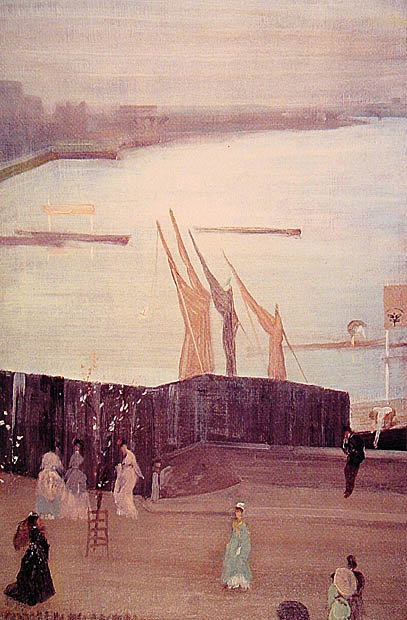
Venetian Scene: 1879
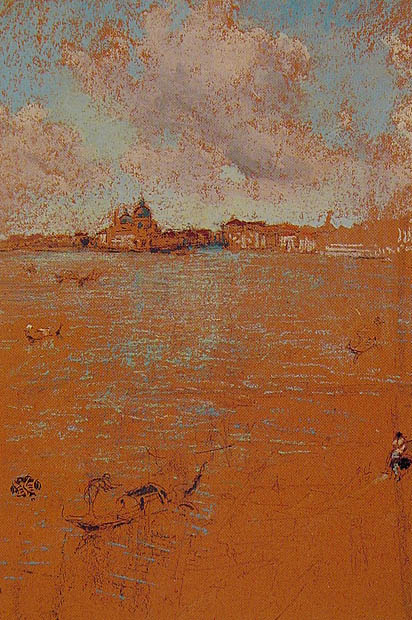
Wapping: 1861
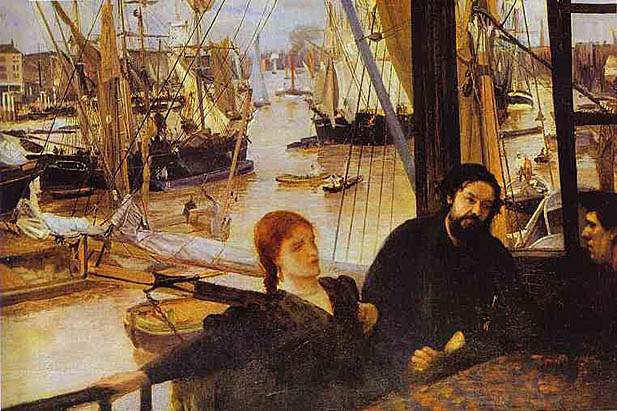
Winter Evening: 1880

The Arabian

The Red Glove

The Rose Scarf
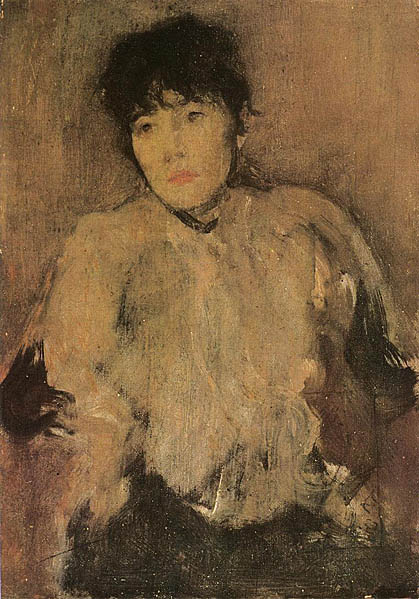
Violet and Silver: A Deep Sea
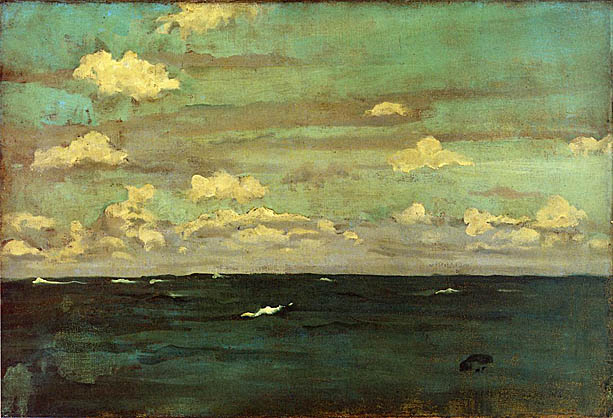
Arrangement in Black No 3: Sir Henry Irving as Philip II of Spain

This page is the work of Senex Magister
Return to Pagina Artis
Return to Bruce and Bobbie's Main Page.

























































.jpg)








_1873.jpg)


































